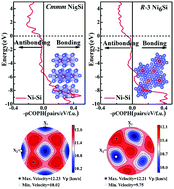Exploring the structures and properties of nickel silicides at the pressures of the Earth’s core†
Abstract
Given the highly possible existence of nickel and silicon in the Earth's core, the study of the reaction between Ni and Si and the resulting structures at the pressure corresponding to that of the Earth's core is highly required. Therefore, we have investigated the crystal structures of Ni–Si compounds at pressures of 0–350 GPa by adopting a crystal structure search algorithm in conjunction with first-principles calculations. We uncover two high Ni-content Ni5Si and Ni6Si compounds with 12-coordination Si bonded with Ni, with both showing strong chemical stability in the Earth’s core. Bonding analysis reveals that the Ni atoms in these Ni–Si compounds present oxidant features and act as electron acceptors. This distinctive anomaly is the natural result of the energy shifts of the Ni 3d and Si 3p bands, resulting in charge transfer from Si to Ni. By examining the key properties (e.g., density and sound velocities) of the Ni5Si and Ni6Si compounds, the obtained density lies within the range of the Earth’s inner core, and the estimated sound velocities are found to be consistent with seismic data. These results indicate that these two compounds could be considered as possible core constituents. Our findings provide valuable insights into the enigmatic Earth's core as well as geophysical and geochemical processes.

- This article is part of the themed collection: 2021 PCCP HOT Articles


 Please wait while we load your content...
Please wait while we load your content...